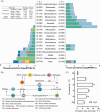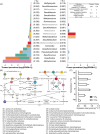Microorganisms as bio-filters to mitigate greenhouse gas emissions from high-altitude permafrost revealed by nanopore-based metagenomics
- PMID: 38868568
- PMCID: PMC10989947
- DOI: 10.1002/imt2.24
Microorganisms as bio-filters to mitigate greenhouse gas emissions from high-altitude permafrost revealed by nanopore-based metagenomics
Abstract
The distinct climatic and geographical conditions make high-altitude permafrost on the Tibetan Plateau suffer more severe degradation than polar permafrost. However, the microbial responses associated with greenhouse gas production in thawing permafrost remain obscured. Here we applied nanopore-based long-read metagenomics and high-throughput RNA-seq to explore microbial functional activities within the freeze-thaw cycle in the active layers of permafrost at the Qilian Mountain. A bioinformatic framework was established to facilitate phylogenetic and functional annotation of the unassembled nanopore metagenome. By deploying this strategy, 42% more genera could be detected and 58% more genes were annotated to nitrogen and methane cycle. With the aid of such enlarged resolution, we observed vigorous aerobic methane oxidation by Methylomonas, which could serve as a bio-filter to mitigate CH4 emissions from permafrost. Such filtering effect could be further consolidated by both on-site gas phase measurement and incubation experiment that CO2 was the major form of carbon released from permafrost. Despite the increased transcriptional activities of aceticlastic methanogenesis pathways in the thawed permafrost active layer, CH4 generated during the thawing process could be effectively consumed by the microbiome. Additionally, the nitrogen metabolism in permafrost tends to be a closed cycle and active N2O consumption by the topsoil community was detected in the near-surface gas phase. Our findings reveal that although the increased thawed state facilitated the heterotrophic nitrogen and methane metabolism, effective microbial methane oxidation in the active layer could serve as a bio-filter to relieve the overall warming potentials of greenhouse gas emitted from thawed permafrost.
Keywords: frame‐shift correction; global warming; high‐altitude permafrost; metatranscriptome; nanopore sequencing.
© 2022 The Authors. iMeta published by John Wiley & Sons Australia, Ltd on behalf of iMeta Science.
Conflict of interest statement
The authors declare no conflicts of interest.
Figures




Similar articles
-
Metagenomic analysis of a permafrost microbial community reveals a rapid response to thaw.Nature. 2011 Nov 6;480(7377):368-71. doi: 10.1038/nature10576. Nature. 2011. PMID: 22056985
-
Ecosystem carbon response of an Arctic peatland to simulated permafrost thaw.Glob Chang Biol. 2019 May;25(5):1746-1764. doi: 10.1111/gcb.14574. Epub 2019 Feb 25. Glob Chang Biol. 2019. PMID: 30681758
-
Genomic insights into redox-driven microbial processes for carbon decomposition in thawing Arctic soils and permafrost.mSphere. 2024 Jul 30;9(7):e0025924. doi: 10.1128/msphere.00259-24. Epub 2024 Jun 11. mSphere. 2024. PMID: 38860762 Free PMC article.
-
Dynamics of microbial communities and CO2 and CH4 fluxes in the tundra ecosystems of the changing Arctic.J Microbiol. 2019 May;57(5):325-336. doi: 10.1007/s12275-019-8661-2. Epub 2019 Jan 16. J Microbiol. 2019. PMID: 30656588 Review.
-
How do forest fires affect soil greenhouse gas emissions in upland boreal forests? A review.Environ Res. 2020 May;184:109328. doi: 10.1016/j.envres.2020.109328. Epub 2020 Mar 5. Environ Res. 2020. PMID: 32163772 Review.
Cited by
-
Microbes Saving Lives and Reducing Suffering.Microb Biotechnol. 2025 Jan;18(1):e70068. doi: 10.1111/1751-7915.70068. Microb Biotechnol. 2025. PMID: 39844583 Free PMC article. No abstract available.
-
Metagenomic sequencing combined with flow cytometry facilitated a novel microbial risk assessment framework for bacterial pathogens in municipal wastewater without cultivation.Imeta. 2023 Jan 5;2(1):e77. doi: 10.1002/imt2.77. eCollection 2023 Feb. Imeta. 2023. PMID: 38868349 Free PMC article.
-
The Role of Thermokarst Lake Expansion in Altering the Microbial Community and Methane Cycling in Beiluhe Basin on Tibetan Plateau.Microorganisms. 2022 Aug 10;10(8):1620. doi: 10.3390/microorganisms10081620. Microorganisms. 2022. PMID: 36014037 Free PMC article.
-
Effects of autumn diurnal freeze-thaw cycles on soil bacteria and greenhouse gases in the permafrost regions.Front Microbiol. 2022 Dec 1;13:1056953. doi: 10.3389/fmicb.2022.1056953. eCollection 2022. Front Microbiol. 2022. PMID: 36532487 Free PMC article.
-
Strategies and tools in illumina and nanopore-integrated metagenomic analysis of microbiome data.Imeta. 2023 Jan 9;2(1):e72. doi: 10.1002/imt2.72. eCollection 2023 Feb. Imeta. 2023. PMID: 38868337 Free PMC article. Review.
References
-
- Tarnocai, C. , Canadell J. G., Schuur E. A. G., Kuhry P., Mazhitova G., and Zimov S.. 2009. “Soil Organic Carbon Pools in the Northern Circumpolar Permafrost Region.” Global Biogeochemical Cycles 23: GB2023. 10.1029/2008GB003327 - DOI
-
- Zhao, Dongsheng , and Wu Shaohong. 2019. “Projected Changes in Permafrost Active Layer Thickness Over the Qinghai‐Tibet Plateau Under Climate Change.” Water Resources Research 55: 7860–75. 10.1029/2019wr024969 - DOI
-
- Wu, Qingbai , Hou Yandong, Yun Hanbo, and Liu Yongzhi. 2015. “Changes in Active‐layer Thickness and Near‐Surface Permafrost Between 2002 and 2012 in Alpine Ecosystems, Qinghai‐Xizang (Tibet) Plateau, China.” Global and Planetary Change 124: 149–55. 10.1016/j.gloplacha.2014.09.002 - DOI
LinkOut - more resources
Full Text Sources
